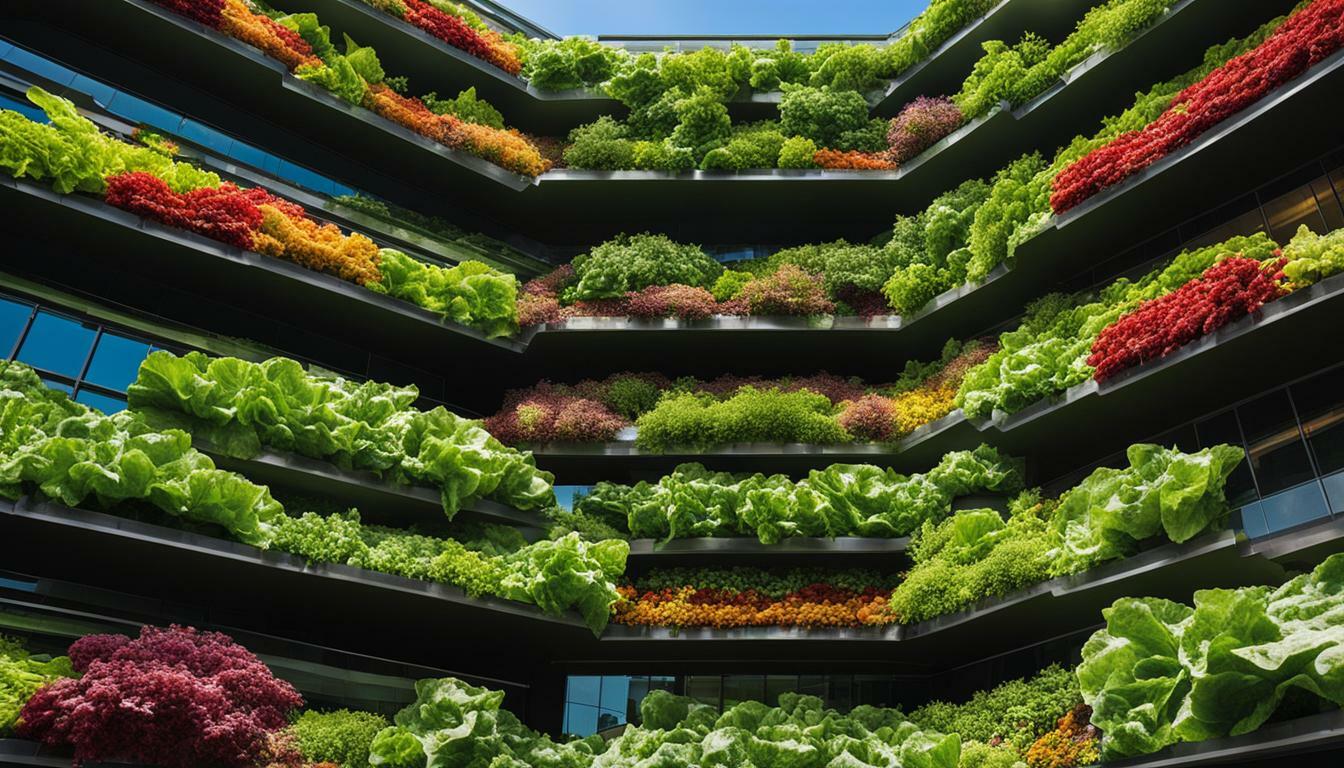Welcome to our guide on creating an efficient vertical garden specifically designed for growing lettuce. Learn how to maximize your green space and enjoy fresh, nutrient-dense lettuce right at home. Vertical gardening is a fantastic solution for those who are tight on space or want to explore innovative gardening techniques. By utilizing vertical space, you can make the most of your area and cultivate a thriving lettuce garden.
Key Takeaways:
- Vertical gardening allows you to grow lettuce and maximize your green space
- Benefits of vertical gardening include increased yields, reduced plant problems, healthier growth, and easier maintenance
- Choose the right lettuce varieties and ensure adequate sunlight for successful vertical gardening
- Various structures and trellises can be used to build efficient vertical gardens for lettuce
- Explore indoor vertical gardening techniques such as hydroponic systems for growing lettuce
- Efficient watering techniques, such as micro irrigation systems, can optimize water delivery in vertical gardens
- Get creative with DIY vertical gardening ideas specifically tailored for growing lettuce
- Troubleshoot common challenges in vertical lettuce gardens, including pests and diseases
- Remember to make the most of your vertical lettuce garden and enjoy the bountiful harvest
Benefits of Vertical Gardening
Vertical gardening offers numerous benefits that make it an ideal solution for growing lettuce. Let’s explore some of the advantages of this innovative gardening technique.
- Increased Yields: One of the key benefits of vertical gardening is the ability to maximize the use of space, resulting in higher yields. By growing lettuce vertically, you can make the most of your available green space and harvest a heartier crop.
- Reduced Plant Problems: Vertical gardening helps to minimize common plant problems. When lettuce plants are elevated off the ground, they are less susceptible to disease. Improved air circulation and faster drying after watering reduce the risk of moisture-loving fungi, such as powdery mildew and rusts. In addition, pests and diseases are more visible on vertical plants, allowing for early detection and timely intervention.
- Healthier Growth: Growing lettuce vertically exposes more leaf surface to sunlight, promoting healthier growth. When plants aren’t sprawling on the ground, they receive better sun exposure, which can result in stronger and more vigorous plants.
- Easier Maintenance: Vertical gardening is not only beneficial for plant growth but also for the gardener. By growing lettuce vertically, you can minimize the need for bending and kneeling, making maintenance tasks easier on your back. You can stand up while caring for your plants and harvesting, reducing physical strain.
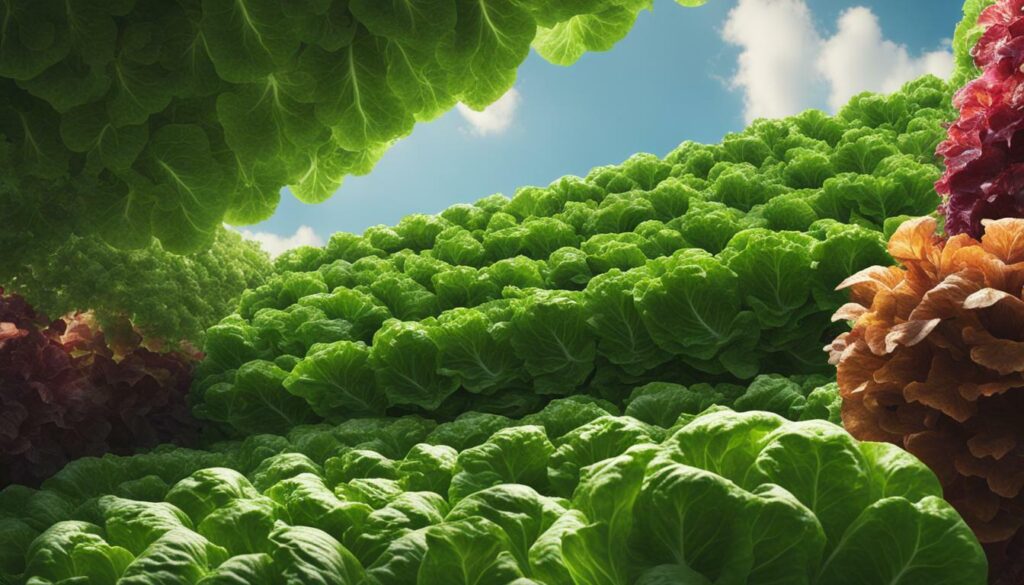
While there are many benefits to vertical gardening, it’s important to note that it may require more frequent watering. Wall-mounted planters, in particular, may need regular watering due to the rain shadow cast by the wall. However, micro or drip irrigation systems can be used to deliver water efficiently and can be automated with timers to optimize water delivery.
In summary, vertical gardening provides a range of advantages for growing lettuce, including increased yields, reduced plant problems, healthier growth, and easier maintenance. By embracing this innovative gardening technique, you can maximize your green space and enjoy the benefits of fresh, homegrown lettuce.
Choosing the Right Crops for Vertical Gardening
When it comes to growing lettuce in a vertical garden, choosing the right crops is crucial. Let’s explore the ideal lettuce varieties for vertical gardening and the importance of sunlight.
Vertical gardening offers a unique opportunity to grow a variety of lettuce in a compact space. When selecting lettuce varieties for vertical gardening, consider vining or trailing varieties that can be trained to grow up a trellis or support. These types of lettuce take up less horizontal space on the ground, making them perfect for maximizing your vertical garden.
Some recommended lettuce varieties for vertical gardening include:
- Romaine lettuces, such as ‘Crisphead’, ‘Little Gem’, and ‘Romanesco’, which have upright growth habits that make them suitable for trellises.
- Leafy lettuces, such as ‘Red Oakleaf’, ‘Green Ice’, and ‘Lollo Rossa’, which have loose, sprawling growth habits that can be trained up supports or allowed to cascade down.
- Butterhead lettuces, such as ‘Bibb’, ‘Buttercrunch’, and ‘Boston’, which have compact, rosette-like growth habits that are ideal for containers and vertical planters.
To ensure successful growth, it’s important to provide your lettuce plants with adequate sunlight. Lettuce generally requires 6 to 8 hours of direct sunlight daily. Position your vertical garden in a location that receives ample sunlight, preferably facing the midday sun or west to catch the afternoon sun. This helps maximize the amount of sunlight that reaches your lettuce plants, promoting healthier growth and faster harvest times.
Remember, different lettuce varieties have varying sunlight requirements, so choose the ones that best align with the sunlight conditions in your vertical garden. It’s also essential to monitor the sunlight exposure and make any necessary adjustments, such as using shade cloth or moving your vertical garden to a sunnier spot, if needed.
By selecting the right lettuce varieties and providing them with the sunlight they need, you can enjoy a bountiful harvest of fresh, homegrown lettuce from your vertical garden.
| Lettuce Variety | Description |
|---|---|
| Romaine lettuces | Upright growth habits suitable for trellises |
| Leafy lettuces | Loose, sprawling growth habits that can be trained up supports or allowed to cascade down |
| Butterhead lettuces | Compact, rosette-like growth habits ideal for containers and vertical planters |
Building Structures for Vertical Gardens
Creating a sturdy and efficient vertical garden structure is essential for successful lettuce growth. Let’s explore some of the best options, including vertical lettuce towers, and get inspired by unique vertical garden ideas.
One popular option for growing lettuce vertically is using a vertical garden tower. Vertical lettuce towers are freestanding structures that allow multiple levels of planting. These towers typically have a compact footprint, making them ideal for small spaces such as balconies or patios. They are designed to maximize space utilization by providing multiple tiers for planting, allowing you to grow a large number of lettuce plants in a relatively small area. Some vertical lettuce towers even come with built-in irrigation systems, making it easier to water your plants.
Another creative idea for vertical lettuce gardening is using repurposed materials, such as pallets or gutters. Pallets can be transformed into vertical garden structures by attaching shelves or pocket planters to the slats. This allows you to create a unique and visually appealing display of lettuce plants. Alternatively, gutters can be mounted onto a wall or fence, providing a narrow and space-saving vertical gardening solution. Simply drill drainage holes in the gutters, fill them with soil, and plant your lettuce seedlings.
For a more DIY approach, you can also consider creating a wall planter for your lettuce. This can be done using materials such as wooden planks or PVC pipes. Attach the planks or pipes vertically to a wall, then add pockets or troughs for planting lettuce. This not only saves space but also adds a decorative element to your vertical garden. You can even get creative with the arrangement of the planters, creating patterns or designs that add visual interest.
To summarize, there are various options for building structures for vertical gardens. Whether you choose a vertical lettuce tower, repurposed materials like pallets or gutters, or a DIY wall planter, the key is to ensure that your structure is sturdy, provides adequate support for the lettuce plants, and allows for proper watering and drainage. With the right structure, you can maximize your green space and enjoy a bountiful harvest of fresh lettuce.
| Structure Type | Advantages |
|---|---|
| Vertical Lettuce Tower | – Compact footprint ideal for small spaces – Multiple tiers for maximum space utilization – Some models come with built-in irrigation systems |
| Repurposed Materials (Pallets or Gutters) | – Creative and visually appealing – Space-saving vertical gardening solution – Can be customized to fit your desired design |
| DIY Wall Planter | – Adds a decorative element to your vertical garden – Can be customized and arranged in unique patterns – Utilizes vertical wall space effectively |
Vertical Gardening Techniques for Lettuce
Indoor vertical gardening opens up a world of possibilities for growing lettuce year-round. Let’s delve into the various techniques, such as hydroponics, and discover how to set up an indoor vertical lettuce garden.
When it comes to growing lettuce indoors, hydroponics is a popular and efficient method. Hydroponics is a soil-less growing technique that relies on a nutrient-rich water solution to deliver essential nutrients directly to the plant roots. This method allows for faster growth and higher yields, making it ideal for lettuce cultivation. By setting up a hydroponic system, you can create a vertical garden that maximizes space while ensuring optimal growth for your lettuce plants.
An indoor vertical lettuce garden can be created using various hydroponic systems, such as the nutrient film technique (NFT) or the deep water culture (DWC) method. These systems typically involve the use of PVC pipes or channels to support the lettuce plants and provide an efficient water and nutrient delivery system. With careful monitoring and adjustment of the nutrient solution and water levels, you can create an ideal growing environment for your lettuce plants.
Additionally, setting up an indoor vertical lettuce garden requires proper lighting. Lettuce plants require at least 12 hours of bright light each day for optimal growth. You can achieve this by using LED grow lights specifically designed for indoor gardening. These lights provide the right spectrum of light for plant growth, ensuring that your lettuce plants receive the necessary light energy to thrive.
By incorporating these techniques, you can create a productive and space-saving indoor vertical garden for lettuce. Whether you choose to use hydroponics or other vertical gardening systems, such as vertical towers or wall planters, the key is to provide the right conditions for your lettuce plants to flourish.
Indoor Vertical Lettuce Garden Setup
To set up an indoor vertical lettuce garden, follow these steps:
- Choose a suitable location with access to natural light or install LED grow lights.
- Select the appropriate hydroponic system based on your available space and desired yield.
- Set up the hydroponic system, ensuring proper water and nutrient delivery.
- Install the LED grow lights at the appropriate height and adjust the light intensity based on the lettuce’s growth stage.
- Plant the lettuce seedlings or seeds in the hydroponic system, following the recommended spacing.
- Maintain proper water and nutrient levels, monitoring the pH and EC levels regularly.
- Provide regular maintenance, including pruning, pest control, and harvesting.
With the right techniques and proper care, your indoor vertical lettuce garden can provide a continuous supply of fresh, homegrown lettuce throughout the year.
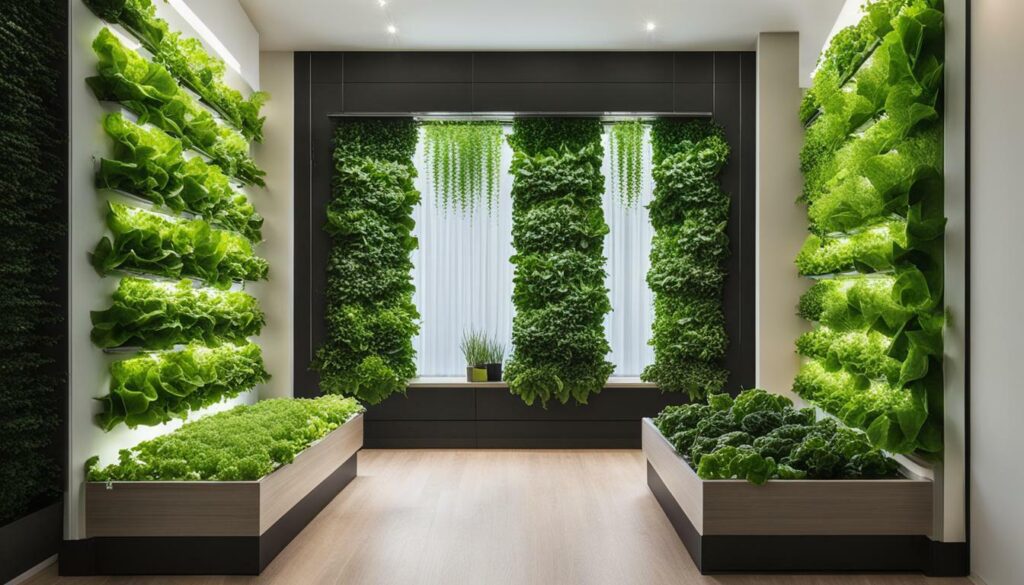
| Lettuce Variety | Recommended for Indoor Vertical Gardening |
|---|---|
| ‘Sungold’ | Yes |
| ‘Black Cherry’ | Yes |
| ‘Gardener’s Delight’ | Yes |
| ‘Blondkopfchen’ | Yes |
| ‘Burpee Hybrid II’ | Yes |
| ‘County Fair 83’ | Yes |
| ‘Dasher 11’ | Yes |
| ‘Saladin’ | Yes |
| ‘Romano Italian’ | Yes |
| ‘Meraviglia Venezia’ | Yes |
| ‘Gold of Bacau’ | Yes |
| ‘Doctor Martin’ | Yes |
| ‘King of the Garden’ | Yes |
| ‘Delicious 51’ | Yes |
| ‘Tigger’ | Yes |
| ‘Sleeping Beauty’ (musk melon) | Yes |
| ‘White Wonder’, ‘Yellow Doll’ (watermelon) | Yes |
| ‘Dual’, ‘Garden Sweet’, ‘Maestro’, ‘Sugar Snap’, ‘Super Sugar Snap’ | Yes |
| Acorn, Delicata, Yellow Summer, Zucchini | Yes |
With these techniques and the right lettuce varieties, you can enjoy the benefits of growing lettuce indoors all year long. Start your indoor vertical lettuce garden and maximize your green space while enjoying the fresh taste of homegrown lettuce.
Efficient Watering Techniques for Vertical Gardens
Watering is a key aspect of maintaining a thriving vertical garden for lettuce. Let’s explore efficient watering techniques, including the use of micro irrigation systems and timers.
Vertical gardens, with their unique structure and positioning, require careful attention to watering. The plants in a vertical garden are often grown in containers or wall planters, which can have limited soil volume and higher rates of evaporation. Additionally, the rain shadow cast by the wall can lead to uneven water distribution and the need for regular irrigation.
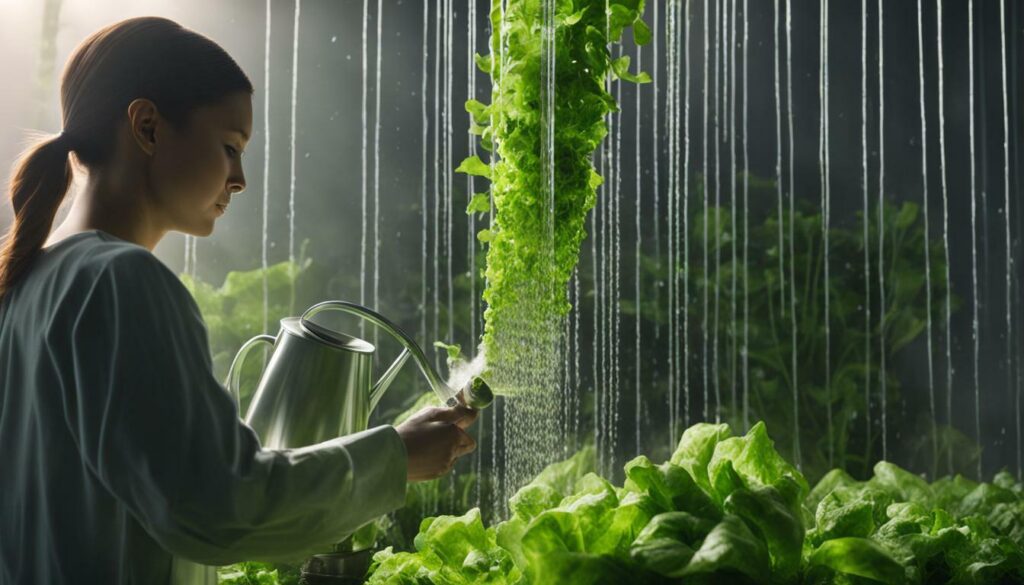
To optimize water delivery and avoid overwatering or underwatering, micro irrigation systems are recommended for vertical gardens. These systems consist of small tubes or drippers that deliver water directly to the plants’ root zones, minimizing water waste and promoting efficient absorption. Coupled with a timer, micro irrigation systems can be automated to ensure consistent and regulated watering, even when you’re away.
| Benefits of Micro Irrigation Systems | Benefits of Timers |
|---|---|
|
|
By implementing micro irrigation systems and timers in your vertical garden, you can maintain optimal moisture levels for your lettuce plants while minimizing water waste and ensuring their healthy growth. Remember to monitor the soil moisture regularly and make adjustments to the watering schedule as needed.
DIY Vertical Gardening Ideas for Lettuce
Get your creative juices flowing with these DIY vertical gardening ideas for growing lettuce. Discover how to create stunning wall planters, repurpose gutters, and make your own bottle gardens.
Wall Planters
One easy way to make a vertical garden in an attractive way is a trellis panel secured onto the wall to support a range of pots planted with herbs, vegetables, and flowers. Wall planters can brighten up any space, whether it’s a small backyard or a balcony in Baton Rouge. They are great for growing herbs or greens that don’t need too much soil or space to grow. You can easily snip off fresh lettuce for your salads whenever you want.
One DIY option is to use buckets or containers and hang them on the wall. Ensure they get enough sun and have proper drainage. To make weeding easier, you can secure the planters to the trellis with sturdy garden twine or hooks. Keep the plants watered regularly to prevent drying out, and don’t forget to harvest regularly and replant as needed.
Gutters
Repurposing gutters into vertical gardens is another creative option. Cut gutters to your desired length and attach them to the sides of your fence, shed, or even your house. Ensure that there is enough space between the gutters for sunlight to reach the plants and drill drainage holes to prevent overwatering. The excess water will drip down onto the lower levels, creating a self-watering system.
Use gutters to grow lettuce, salad greens, or even small herbs. The length of the gutters allows for multiple planting spots, maximizing the use of vertical space. It’s an efficient way to grow fresh produce while conserving space and resources.
Bottle Garden
A bottle garden is a great DIY project for the whole family and a fantastic way to keep plastic bottles out of the landfill. Simply cut a hole in the side of any soda or water bottle and attach it to any vertical structure. Fill it with soil and plant small plants like herbs and salad greens. You can use multiple bottles to create a beautiful and functional bottle garden.
Bottle gardens are ideal for growing lettuce and other small plants. They are easy to maintain and provide a unique display for your home or garden. Plus, they are a sustainable way to repurpose plastic waste and grow your own fresh produce.
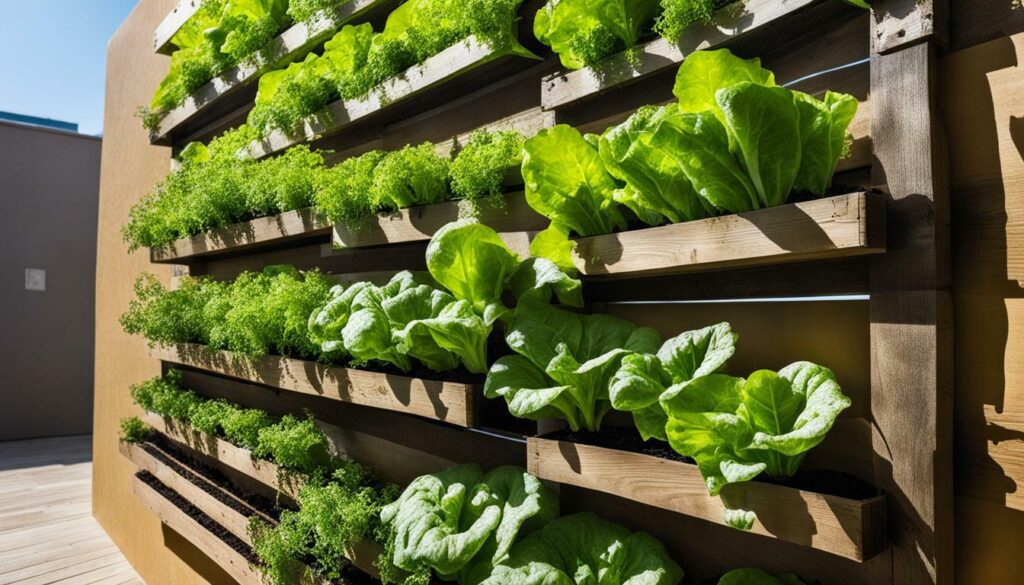
| Lettuce Varieties | Recommended Varieties |
|---|---|
| Cherry Tomato | ‘Sungold’, ‘Black Cherry’, ‘Gardener’s Delight’, ‘Blondkopfchen’ |
| Cucumber | ‘Burpee Hybrid II’, ‘County Fair 83’, ‘Dasher 11’, ‘Saladin’ |
| Green Bean | ‘Romano Italian’, ‘Meraviglia Venezia’, ‘Gold of Bacau’ |
| Lima Bean | ‘Doctor Martin’, ‘King of the Garden’ |
| Melon | ‘Delicious 51’, ‘Tigger’, ‘Sleeping Beauty’ (musk melon); ‘White Wonder’, ‘Yellow Doll’ (watermelon) |
| Pea | ‘Dual’, ‘Garden Sweet’, ‘Maestro’, ‘Sugar Snap’, ‘Super Sugar Snap’ |
| Squash | acorn, delicata, yellow summer, zucchini |
These DIY vertical gardening ideas provide creative and space-saving solutions for growing lettuce. From wall planters to repurposed gutters and bottle gardens, you can maximize your green space and enjoy fresh, homegrown produce. Experiment with these ideas and find the perfect vertical gardening setup that suits your needs and preferences.
Troubleshooting Vertical Lettuce Gardens
While vertical gardening has numerous benefits for lettuce cultivation, it’s important to be aware of potential challenges and how to overcome them. Let’s explore common issues and effective troubleshooting techniques.
Pests and Diseases
One of the key challenges in vertical lettuce gardening is dealing with pests and diseases. Lettuce plants are susceptible to aphids, slugs, snails, and diseases like powdery mildew and downy mildew.
To tackle pests, regularly inspect your plants and remove any affected leaves or insects. You can also use natural remedies like insecticidal soaps or introduce beneficial insects like ladybugs to control pest populations.
For diseases, ensure proper air circulation by spacing your plants adequately and avoiding overcrowding. If powdery mildew or downy mildew appears, treat the affected plants with preventative fungicides or organic solutions like neem oil.
Watering and Irrigation
Proper watering is crucial for the success of vertical lettuce gardens. Overwatering can lead to root rot, while underwatering can cause wilting and stunted growth.
Consider using a micro irrigation system or drip irrigation to efficiently deliver water to your plants. These systems can be automated with timers to ensure consistent and optimal watering.
Monitor the moisture levels of the soil regularly and adjust your watering schedule accordingly. It’s important to strike a balance between keeping the soil moist and preventing waterlogged conditions.
Lack of Sunlight
Lettuce requires adequate sunlight for healthy growth and development. In vertical gardens, shading from surrounding structures or taller plants can limit the amount of sunlight reaching your lettuce plants.
Ensure that your vertical garden is positioned in a location that receives at least 6 to 8 hours of direct sunlight per day. If necessary, consider using reflective materials or adjusting the structure of your garden to maximize sunlight exposure.
Additionally, choose lettuce varieties that are tolerant of partial shade or grow them in areas that receive the most sunlight during the day.
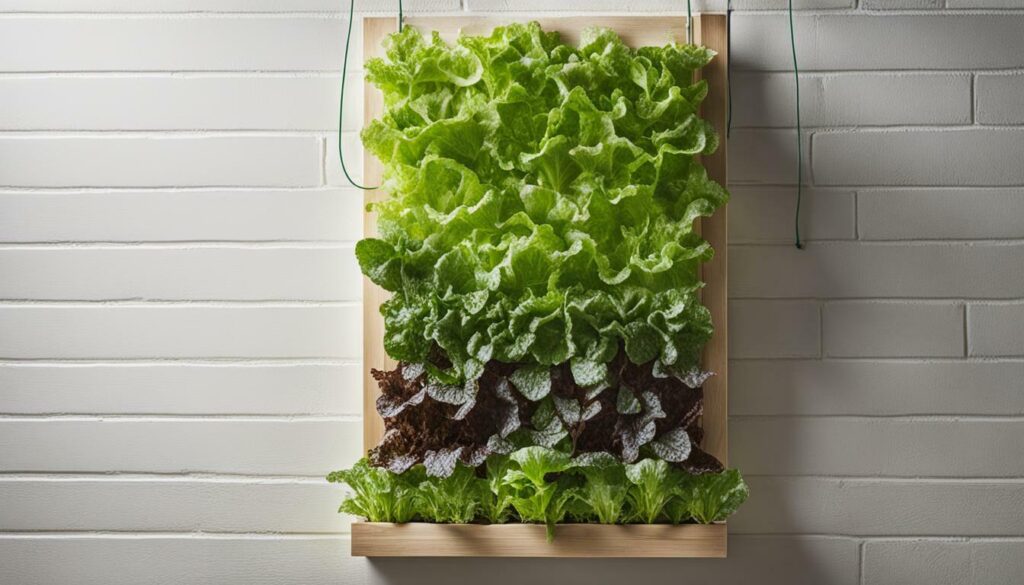
| Pest | Prevention and Control |
|---|---|
| Aphids | Remove affected leaves, introduce beneficial insects, use insecticidal soap |
| Slugs and Snails | Create physical barriers, handpick, use beer traps, copper tape |
| Powdery Mildew | Improve air circulation, use preventative fungicides, neem oil |
| Downy Mildew | Ensure proper drainage, remove affected leaves, use copper-based fungicides |
By addressing these common challenges and implementing effective troubleshooting techniques, you can ensure the success of your vertical lettuce garden. Enjoy the benefits of maximizing your green space and delight in the freshness of homegrown lettuce!
Conclusion
In conclusion, vertical gardening offers an efficient and innovative solution for growing lettuce, allowing you to maximize your green space and enjoy fresh, nutrient-dense produce right at home. By utilizing vertical space with structures such as trellises, wall planters, and stackable planters, you can grow lettuce and other vegetables in a compact and organized manner.
Vertical gardening provides several benefits, including increased yields, reduced plant problems, healthier growth, and easier maintenance. It also allows for better air circulation, which reduces the risk of diseases and pests. Choosing the right lettuce varieties and providing adequate sunlight are crucial for successful vertical gardening.
Various structures like trellises, arches, and pergolas can be used to support climbing lettuce plants and maximize space utilization. Additionally, DIY ideas such as wall planters, gutters, bottle gardens, and PVC towers offer creative and space-saving solutions for vertical lettuce gardening.
To ensure optimal watering in vertical gardens, micro irrigation systems and timers can be employed for efficient water delivery. However, it’s important to note that vertical gardens may require more frequent watering, especially wall-mounted planters.
While vertical gardening offers numerous advantages, it’s essential to be aware of potential challenges and maintenance tips. Troubleshooting common issues like pests, diseases, and proper maintenance practices will help ensure the success of your vertical lettuce gardens.
Overall, vertical gardening for lettuce is a practical and sustainable method for maximizing green space and enjoying a bountiful harvest. Whether you choose to create a vertical garden indoors or outdoors, this innovative approach offers a rewarding gardening experience while enhancing the beauty and productivity of your space.
What Are the Benefits of Vertical Lettuce Gardens for Urban Farming?
Vertical lettuce gardens offer numerous benefits for the future of urban farming. They maximize limited space, reduce water usage, and allow for year-round cultivation. Furthermore, they provide fresh, locally grown produce in urban areas, promoting sustainability and community resilience. The future of urban farming looks promising with innovative solutions like vertical lettuce gardens.
FAQ
Q: What are the benefits of vertical gardening?
A: Vertical gardening offers increased yields, fewer plant problems, healthier growth, and easier maintenance. It also maximizes green space and allows for efficient use of resources like water and fertilizer.
Q: Which crops are best for vertical gardening?
A: Vining crops like pole beans, climbing peas, vining tomatoes, and sprawling types of zucchini, cucumber, melon, and squash are ideal for vertical gardening. These crops can be trained to grow up on trellises, saving horizontal space.
Q: What structures can be used for vertical gardens?
A: Various structures like trellises, tripods, arches, pergolas, gazebos, wire cages, netting, bamboo poles, and more can be used for vertical gardens. The choice of structure depends on the plant’s characteristics and the desired visual appeal.
Q: How can I water my vertical garden efficiently?
A: Wall-mounted planters and vertical gardens generally require more frequent watering. Micro or drip irrigation systems coupled with timers can automate water delivery and ensure efficient use of water.
Q: What are some DIY vertical gardening ideas?
A: You can create a living wall with a trellis panel and pots, repurpose gutters into a vertical garden, or use plastic bottles to create a bottle garden. Another idea is to make a vegetable arch using galvanized metal uprights and cattle panels.
Q: What are common challenges in vertical gardening?
A: Common challenges in vertical gardening include dealing with pests and diseases, ensuring proper plant support and stability, and maintaining the vertical garden’s overall health and appearance.

